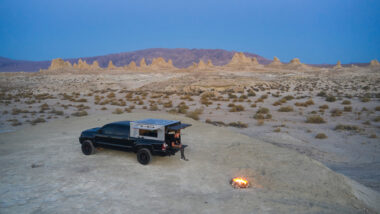Table of Contents Show
While Yellowstone National Park is famous for its geothermal features, don’t overlook its wildlife. Catching a glimpse of these magnificent creatures in their natural habitat can be an unforgettable experience.
Unfortunately, spotting some of them in the wild isn’t always easy. You may have to put in a little effort to catch a glimpse of them.
Today, we’re grabbing our binoculars and looking at the wildlife living inside Yellowstone National Park.
Let’s dive in!
About Yellowstone National Park
Yellowstone National Park sits primarily in Wyoming, but small portions lie within Montana and Idaho. While Native American tribes inhabited the land for thousands of years, it became the world’s first national park on March 1, 1872.
Its 2.2 million acres are full of constantly changing landscapes. You’ll find everything from deep canyons to towering mountains. In addition, you can walk along boardwalks as you watch Old Faithful erupt or view the stunning colors of Grand Prismatic Spring.
You can hit the trails or do a scenic drive and have an incredible experience. Whether you get out of your car or not, the park offers something for everyone. You’ll leave with a phone full of pictures and priceless memories you’ll never forget.
What Is the Largest Animal in Yellowstone National Park?
The largest animal living within Yellowstone National Park is the American Bison. These massive bundles of fur can weigh over 2,000 pounds and stand over six feet tall at their shoulders.
They may move slowly and with purpose, but don’t get too close. We’ll chat more specifically about them later, but they’re less friendly than they look. One false move, and you could end up with a horn through your side.

Is the Wildlife in Yellowstone National Park Dangerous?
The beauty of Yellowstone National Park is out of this world. However, don’t let it distract you from the dangers surrounding you. There is dangerous wildlife walking throughout the park. While many will do whatever they can to keep their distance from humans, encounters can occur.
Despite frequent warnings from officials, we’re constantly hearing about another close encounter. More often than not, it’s the humans seeking the animals out, not vice versa.
We can’t understate it enough that you should keep your distance from all wildlife, no matter how dangerous they may or may not appear.
Wildlife to Watch for in Yellowstone National Park
So, what wildlife can you spot in Yellowstone National Park? Let’s take a look and see what animals you need to keep an eye out for while you’re exploring here.
Bison
As we mentioned, bison are the largest animal in Yellowstone National Park. However, don’t let their size and docile appearance trick you. These massive mammals can run upwards of 30 mph, which is much faster than you.
If you get too close or they feel threatened, they will respond. Deaths are rare as most encounters end when the bison no longer perceives you as a threat.
Estimates are that the park has approximately 5,000 bison in its herd. You can typically find them in Lamar Valley in the early morning and late afternoon. Additionally, Hayden Valley, Mud Volcano Area, and along the roadside throughout the park are some of the most common spots to see them.
Pro Tip: There are more than 2,000 campsites within Yellowstone, but they get snatched up quickly. Before you start planning your camping trip, you’ll want to know about these Yellowstone Camping reservation tips.

Elk
Elk are another common sight for visitors throughout the park. Officials believe roughly 10,000 to 20,000 elk live within the park. Some of the most popular spots to see them are Lamar and Hayden Valleys, along the Madison River and near the Gardiner River. However, they often migrate from one park section to another throughout the year.
You’ll likely not get too close to them as they often keep their distance. However, they’ll stand between 4.5 to 5 feet tall at their shoulders. Males can weigh 700 to 1000 pounds, and females can weigh between 500 and 600 pounds.
Bears
Bears are the wildlife that most visitors fear encountering while in Yellowstone National Park. The park is home to black and brown (grizzly) bears. While black bears may be less aggressive and more skittish, you don’t want to mess with either one. The 150 to 200 grizzly bears that live within the park are no joke.
If you plan to hike or explore on foot, you must remain bear-aware. Carrying bear spray is non-negotiable, and you don’t want to find yourself in an encounter without it. Spotting a bear is more challenging than most people think.
For the best chance, visit Lamar Valley, Dunraven Pass, and Hayden Valley. If you don’t have any luck, the Grizzly & Wolf Discovery Center is just outside the park’s boundary. This facility offers the opportunity to see these creatures up close and to learn about them.
Gray Wolves
Gray Wolves had disappeared from Yellowstone National Park, but officials reintroduced them in the mid-1990s. This helped officials create a natural and balanced ecosystem. You will most likely not spot these elusive creatures without a tremendous amount of luck.
Estimates are that only 100 to 150 Gray Wolves live within the park. They’re very cautious and will keep their distance from humans. However, there have been sightings in Lamar Valley, Hayden Valley, Dunraven Pass, and near the Washburn Hot Springs Overlook.
Pro Tip: RVing is one of the best ways to experience Yellowstone. See how to plan an RV trip to Yellowstone!
Bighorn Sheep
Bighorn sheep are also challenging to find in Yellowstone National Park. This is primarily because their numbers are so meager. In 2018, the park did some study and discovered 345 bighorn sheep, below the 10-year average. Their numbers are constantly changing as disease and predators make it challenging for them to survive.
You’ll want to travel to Mount Washburn, Lamar Valley, or Gardiner Canyon for the best opportunity to see them. Keep a watchful eye on areas with rocky and mountainous terrain. Their color camouflages them from their surroundings.
Stop at a visitor center or ranger station and chat with officials to see if they’ve spotted any bighorn sheep lately. They can point you in the right direction and offer helpful tips for spotting them.

Mountain Lions
Mountain lions are among the most elusive wildlife in Yellowstone National Park. You’ll seldom see them in the park, and confrontations with guests are rare. The park estimates that 34 to 42 of them remain in the park.
Unfortunately, spotting one of these isn’t going to be easy. They often hang out in remote and rugged terrains throughout the park. They move slowly, are usually nocturnal, and are most active during dawn and dusk. You’ll have to get away from major roads and popular attractions for the best chance to spot one of them.
Birds
While we’ve been talking about the wildlife in Yellowstone National Park on the ground, hundreds of species of birds fly in the sky. It’s common to spot bald eagles, osprey, raptors, and waterfowl.
Lamar Valley is a fantastic spot for birdwatching, but you can’t go wrong in any meadows, trails, or along the banks of lakes and rivers. Just about anywhere you can sit patiently and quietly can become a birdwatcher’s paradise. Bring your binoculars and a chair to enjoy the view comfortably.

Where Is the Best Place to Spot Wildlife in Yellowstone National Park?
Many refer to Lamar Valley as the “Serengeti of North America.” That’s because it’s the prime spot for wildlife viewing in Yellowstone National Park. You can see bison, elk, pronghorn, wolves, and even grizzly bears.
If you’re not having any luck in Lamar Valley, head to Hayden Valley. This is another popular hotspot for wildlife viewing. This spot is best in the early morning and late afternoon. However, other popular sites include Mammoth Hot Springs, around Old Faithful, and Gardiner Canyon.
Spot the Diverse Wildlife of Yellowstone National Park
Yellowstone National Park is home to a tremendous amount of diverse wildlife. Driving throughout the park and trying to spot as many as you can can be a fun adventure.
Just make sure you give them space and avoid provoking them. If not, you could find yourself in legal trouble or on the receiving end of a headbutt from an angry bison.
What wildlife have you seen in Yellowstone National Park?






